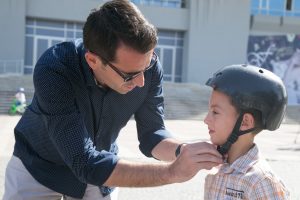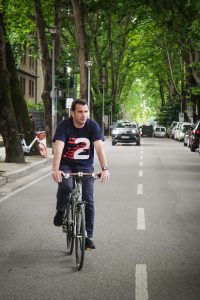A century of life for capital is not much, as long as there is no point in comparing it to human life. However, such a birthday was a moment of reflection on the journey of the nearly 400-year-old city, to understand what is left behind and to do the best for what we still have ahead.
***
Since its beginning, Tirana, famous today for its colourful buildings, sunny days, authentic food, and cultural diversity stemming from a rich history as much as Ottoman, Italian and no less Communist period influences, has been an entwine between roads and human destinies.
As a capital city, the beginnings were modest but ambitious. Political, economic and cultural ties with Italy influenced urban development. We still have the footprints of the top architects of that time, such as Bosio, Brasini and Fausto, and we are proud of the transformation they have made of this place with inhabitants echoing a gentle nature full of light. At that time, our famous boulevard was designed, which was projected in an area outside the city and consequently not constructed, giving birth to an expression that became popular: “boulevard without a city.” In reality, when “Dëshmorët e Kombit” boulevard – designed by visionaries – was inaugurated, it was more than a match for the city. Later on, the city extended its legs around the boulevard very quickly, just as it won’t be long before the city expands to its extension that we inaugurated a while ago… To project does not mean to see beyond the end of your nose but to look far, as far as the eye can see.
The time which separates the two boulevards of Tirana was a time of dictatorship, in other words, a time of agony for the city. Fortunately, dictatorships collapse, as dictatorships always do. The transition to the desired democracy was both dramatic and chaotic. Tirana became a place of abuse: In the absence of proper urban planning, anyone could build wherever they wanted. The city was no longer a city.

Under these long-lasting conditions, we took office seven years ago, inheriting exactly the chaos. We were very familiar with that. We were aware of the workload that awaited us. But what we knew for sure was that it could not go on like that in a capital, which was more than just a city located in the heart of Europe. We did not have a priority to the detriment of another. Work began simultaneously pushing all projects forward on one front.
Unable to mention them all, I want to emphasize the Skanderbeg Square, now completely transformed, exclusively for pedestrians. What used to be a 40,000 m² roundabout dedicated to vehicles, is currently the largest square in Tirana, where people don’t just walk, but can stand between mini-parks with the greenery that surrounds them and the water sparks that regulate the microclimate. It was not out of the blue that, in 2018, this square won the European award for Public Urban Space in Barcelona. Selfsame we transformed the New Bazaar and the City Castle into public spaces: a modern look with strong traditional motives.
Now it is the turn of new projects: The Zoo, which has been missing for years for humans and turned into an animal prison, will be inaugurated in a few months. The Pyramid of Tirana, once a symbol of communism, will be a centre of innovation and learning of the basics of technology and coding for children and young people.
***
There is always more to do, especially in a city like Tirana. Obstacles did not discourage us even though we had plenty of them. Not to mention the pandemic that jammed the whole world, we went through the hardships of a devastating earthquake. But we saw crises as opportunities. If we are going to talk about the fundamental changes in the urban fabric of the city – a consequence of the crises I mentioned, I will say that we are in the footsteps of Jean Nouvel who stated that: “Every new situation requires a new architecture”.
After the earthquake, we started working on two large neighbourhoods, 5 Maj and Kombinat, designed by Italian architects Stefano Boeri and Marco Casamonti. It will house thousands of families who lost everything, but it is not just about the roof over their heads: the neighbourhoods are turning into new polycentric centres where citizens will coexist with green spaces, and all services will be no further than “15 minutes” walking or pedalling. We are also building many new schools with modern standards. Last year alone, we opened 14 of them, with many others ready for the ribbon-cutting ceremony!
Ecological projects have given a previously unknown dimension to the city: Today, citizens can walk more or pedal safely on a 45 km network dedicated only to cyclists, thus discouraging the use of cars for short distances within the city. An investment that is, at least, lessening a little the aggravated crisis of inflated oil prices that the whole world is going through!
These developments did not go unnoticed by the international media, such as the Financial Times, which, this year, would evaluate Tirana as a small paradise with the most magical transformation in Europe in the last three decades! We are under way. Allow me to use the history of architecture for a comparison: Gaudi’s “La Sagrada Familia”, a work always in process, still unfinished, brings me to mind Tirana, which is more in progress than in process. Let’s face it: we are already in a more livable, cleaner city, with many times better infrastructure, where the property is worth a lot more than seven years ago.
***
We talk about projects and work, we think about peace, but there is war on the other side of Europe! A photo shot in Kyiv and posted on social media shocked me: it was a window reinforced by a wall of books. Who would have thought that they would serve this purpose too! Well, the inhabitants of a house in Kyiv were hoping for salvation in the books of a library… The photo reminded me of another earlier one, the window of a house in Pristina burnt by the flames. It was the time of another war. The war in Kosovo was not just near us; it was inside us … But, inside us, on the border or away from the geographical frontier, with windows reinforced with books or windows burnt by the flames, the common thing in all cases is the war as a danger to man, and consequently the need for the help of people who suffer it.

So we did not hesitate to reflect: yes, we have our work and worries, but we cannot leave others to suffer. Not because the impact of their suffering comes down to us, but for humanism, for what identifies us as human beings. Thus, the European Youth Capital joined forces to collect and send as much aid as possible to the Ukrainians. We are also ready to welcome them with our open hearts. So to offer, in all forms, friendship, to give them courage. The latter is also done with symbolic gestures, from those that speak a lot and that surely affect others to act. We named “Free Ukraine” the street where the Ukrainian embassy is located. The embassies of Russia, Serbia and Kosovo are located on this street too! If you are a small country to speak the language of sanctions, then you can speak the language of symbols. And, so we will continue to provide aid and solidarity. We are Albanians of a cradle where Mother Teresa was born. We will always walk in the path of the sanctuary.
***
Being the European Youth Capital means a high appreciation grade, that was awarded to us precisely for the good and transformative works, for the process within which we have started the engines. Tirana as the European Youth Capital coincides with the ambition of the European Commission to make 2022 the Year of European Youth. Here is one more reason to see this year as a unique opportunity to connect young people; those in Tirana, with the ones from the region, Europe and worldwide. The epicentre will be here as a platform to display ideas, projects and innovations; to listen to the youngsters’ voices and reflect on their prospects for the transformation of our societies; to see with their own eyes, the most urgent issues affecting the present and the future of the planet. That is why we are implementing a rich calendar of 1000 events and activities throughout this year, but our focus goes beyond them. We want to build the leaders of tomorrow, those who will know how to embrace democratic values, human rights, freedom of expression; those who will make bold decisions, difficult but righteous, distancing themselves from the language of hatred, separatism, nationalism.
***
Tirana today, only 102 years old as the capital, still has a lot of work and projects ahead. However, with the extraordinary changes it is undergoing day by day, it has become a tourist destination for citizens from neighbouring countries, the region and the world who visit on weekends to enjoy good food or visit the art galleries, museums that bring replicas of the communist era, nightlife, and the towns with fairytale nature. Tirana has also become an oasis for many young people who want to start a digital start-up or digital nomads who choose to make Tirana with free-living costs and the Mediterranean climate into their new office. This explains why Tirana has turned from a tourist destination into a permanent home for many Italians. The year 2022, as the European Youth Capital, is an open invitation for the young people of Europe who want to touch the transformation of Tirana, to experience the buzzing atmosphere, and why not turn their dreams and ideas into concrete actions.

